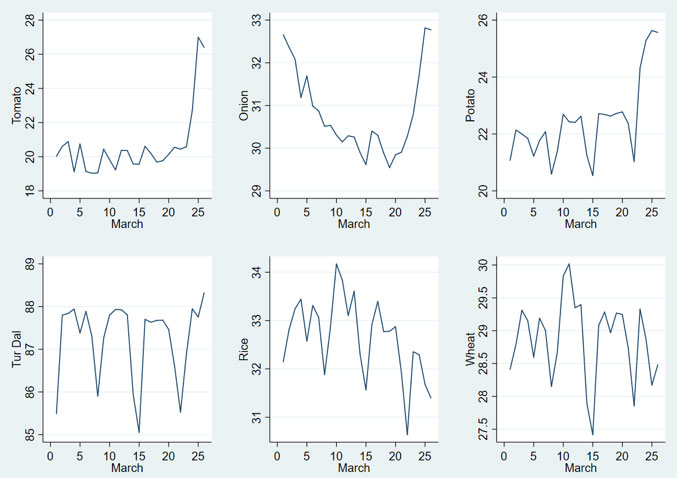As this may be the first of many future lockdowns to stamp out possible repeated outbreaks of Covid-19, policymakers must be prepared to provide relief to adversely affected individuals. With this in mind, the authors propose a comprehensive approach that argues for a combination of in-kind transfers and cash support to be provided to all households with ration cards during any lockdown that takes place over the next 24 months.
There is a lot that is unknown about the SARS-COV-2 virus that is causing the novel Coronavirus disease (Covid-19), but the world’s leading epidemiologists believe that its spread will be a long-drawn process. It will take at least 18 months for a vaccine to become available, and even after that, scaling up vaccine production to cover the entire world population will take a long time. Until then, or until enough people become immune to the virus, we may see multiple outbreaks of the disease, leading to spikes in infections and mortality. Many experts also believe that SARS-COV-2 is seasonal, which could imply outbreaks of COVID-19 cases in winter.
In short, over the next two years, governments around the world will have to spend resources on stamping out repeated outbreaks of the disease, often by ‘locking down’ cities, regions, or entire countries. As we have seen in the few short days of national lockdown so far, these lockdowns come with significant economic costs and impose hardships on many vulnerable people. Policymakers must be prepared to mitigate the costs of lockdown and provide relief to adversely affected individuals. Moreover, they must be ready to announce these measures in advance of a lockdown to prevent the scenes of chaos, panic, and anxiety that we have witnessed over the last few days.
Guiding principles for policy responses
One of the defining aspects of the global pandemic is the fundamental uncertainty associated with it. Both common sense and experimental evidence establishes that almost all people are averse to facing uncertainty in their lives. One important principle that government policy should follow is to not add further uncertainty in these difficult times. There must be a pre-established, forward-looking policy framework in place that commits to providing a safety net to vulnerable people. This should be widely publicised so that the people affected most know what their entitlements are and how to access them.
Policy needs to take a comprehensive view of the vulnerabilities – both material and psychological – that vast sections of the population will be exposed to in the event of repeated lockdowns. Migrants, daily-wage workers, casual labourers, informal sector workers, and many self-employed individuals who do not have any safety net in the form of substantial personal savings will face a sharp drop in incomes potentially leading to hunger, homelessness, and adverse health outcomes. As debilitating as the material consequences of scarcity are, equally striking are the psychological damages that it produces. Specifically, episodes of scarcity have a serious impact on cognition and decision making, leading to adverse outcomes for vulnerable groups (Mullainathan and Shafir 2013).
With this in mind, we propose a comprehensive approach that argues for a combination of in-kind transfers and cash support to be provided to all households with ration cards during any lockdown that takes place over the next 24 months. Given the possibility of prolonged and frequent lockdowns in the future, our proposed transfers are more ambitious than the announced government measures that are in place. We think this is important in order to provide an adequate safety net for millions of Indians who do not have the savings to tide themselves through long periods of economic inactivity.
It is important for the cash and in-kind transfers to work as complements and not as substitutes. Lockdowns are often accompanied by hoarding, disruptions in supply chains, and price fluctuations, which can erode the value of any cash transfer. In order to ensure that these transfers actually provide relief to people, we also emphasise the importance of strengthening the Public Distribution System (PDS) and managing supply chains to maintain the flow of essential commodities.
The implementation of these policies requires coordination across multiple levels of government. We recommend that a robust institutional infrastructure be put in place in order to manage government responses, not just to the current pandemic but to any future pandemics.
In addition, policy should pay attention to specific groups that are more vulnerable to the economic costs of lockdown than others, like women and children, migrant labour, daily-wage earners and self-employed workers, many of whom may struggle to get access to entitlements.
Creating a social safety net
Given long-term uncertainty, likely recurrences of SARS-COV-2 outbreaks and lockdowns, and the significant material and psychological costs associated with them, we recommend a monthly cash transfer to all households in areas that have been locked down, to be supported by in-kind transfers of food and other essential commodities through the PDS system.
Cash transfers:
- During periods of lockdown, we recommend a monthly cash transfer to all households with ration cards in the area of the lockdown. We are, of course, aware that any recommendation of a monthly cash transfer will run into questions about what the right amount for the monthly transfer is. In a companion piece, we have suggested that this amount should vary with the size of the household, and for a household of four, our suggestion (based on poverty line calculations) is a monthly transfer of Rs. 4,300 in urban areas and Rs. 2,600 in rural areas. Is this number too high? We think not. In the calculations below, we show that if the transfer were calculated based on lost earnings from the lockdown, the amount would be much higher.
- Since Aadhaar cards have been seeded with both ration cards and bank accounts, these transfers can be made directly into bank accounts linked to each ration card. To address the concern that the use of the ration card and Aadhaar card may lead to some exclusions of households who possess neither, governments must take steps to address payments claims from individuals who have not been able to access their entitlements. A helpline can be set up to facilitate the processing of claims, and these should be resolved as soon as possible. In rural areas, Gram Panchayats should be given the responsibility to process claims by people who do not have necessary documentation. The sarpanch (village head) could be made responsible for compiling a list of excluded individuals to whom cash will be home-delivered by the banking correspondents.
- In addition to transferring money into bank accounts, steps should be taken to ensure that people have access to cash. To prevent overcrowding at banks and ATMs (automated teller machines) in urban areas, simple rules based on Aadhaar card numbers could be used to allow people to withdraw money. In rural areas, banking correspondents or mobile banking vans could be used to bring cash to each village every month. Since biometric authentication may be risky during this time, specific steps should be taken to work around this requirement. For example, the banking correspondent can first authenticate the identity of a person by verifying their photo identity card (such as the voter ID card), and then taking a photograph of the Aadhaar card before giving out the cash. The banking correspondent can process the transaction later at the bank with the Aadhaar card details of the beneficiaries.
- With 0.23 billion ration card holders and an average household size of four, the total cost to cover the present three weeks of lockdown will come to approximately Rs. 550 billion or about one-tenth of the fiscal deficit (at 3.5% of GDP (gross domestic product)). The proposed transfer will widen the deficit by 0.3 percentage points to 3.8% of GDP. Of course, given the complete shutdown of production, the tax collection for this period would be adversely affected, which will only widen the deficit. Financing this transfer through any sources, be it direct or indirect taxes, trade or domestic and international borrowing, will certainly be challenging, but these costs are dwarfed by the costs of a full-blown pandemic. We believe that a nominal transfer that helps the poor for a very short period of time and forces them back into work in infectious environments will entail much higher long-term costs than a more generous transfer that allows people to safely stay at home, contains the spread of disease, and lowers the number of sick-persons-work days in the economy.
- If lockdowns cover only specific states or districts, cash transfers should extend to households living and working in all the affected areas. As an example, if Delhi was to be locked down for a month, transfers of Rs. 4,300 would be made to all 1.9 million households holding ration cards, at a total cost of Rs. 8.17 billion for the month.
- The availability of the cash transfer should be announced in advance to reduce economic uncertainty during this pandemic.
There are multiple approaches to calculating the cash transfer amount. While our recommendation is based on the poverty line set by the Rangarajan Committee, here we alternatively consider lost earnings as a measure of financial distress, since many daily-wage workers, particularly in urban areas, will not be able to work during a lockdown. The MNREGA (Mahatma Gandhi National Rural Employment Guarantee Act) minimum wage in rural areas is Rs. 202 per day and for urban areas, we adjust this minimum rural wage upwards since average casual worker wages in urban areas are approximately 25% higher than rural wages (Periodic Labour Force Survey, 2017-18). The corresponding urban wage then is Rs. 251 per day. Given female labour force participation (FLFP) rates of 20% in urban areas and 25% in rural areas, and assuming one male earning member in each household, we get monthly household incomes for a typical family of four of Rs. 7,220 in urban areas and Rs. 6,060 in rural areas. If we deduct the monetised value of the recently announced additional rations to be provided through the PDS (20 kg cereals at an average market rate of Rs. 32 per kg, based on retail price data from the Department of Consumer Affairs), we arrive at a cash transfer of approximately Rs. 5,400 per urban household and Rs. 4,200 per rural household. If we were to use the average earnings of daily-wage workers rather than the minimum wages, the transfer figure would be even higher.
In-kind transfers:
- The cash transfers should also be supported by in-kind transfers of cereals, pulses, and other essential commodities. During a lockdown, people find it difficult to access cash at banks or ATMs, and supply chains are disrupted, causing prices of essential goods to rise. The government has already announced increased transfers of free rations of cereals and pulses to households through the PDS system for the next three months. We support these measures and recommend that they be continued in the event of further lockdowns. Biometric authentication, however, may pose an increased risk during this period and should be suspended if appropriate, as many states have already done.
- Since people, particularly the elderly, might find it difficult to travel to PDS shops during periods of lockdown, in-kind transfers can also be made through other means like door-step delivery through PDS trucks.
- The role of PDS shops needs to be reimagined. In addition to cereals and pulses, vegetables like potatoes, onions, tomatoes, and salt that are essentials for Indian households, should also be made available through these fair price shops at reduced rates, if possible.
- In the event of more frequent and prolonged lockdowns, the list of essential goods required to run households will need to be expanded. To mitigate policy uncertainty, a comprehensive list of essential commodities needs to be drawn up that includes all goods necessary for running households (for example, looking beyond food to other requirements such as electrical and plumbing parts, and packaged food).
Supporting the supply of essential goods
The provision of cash and in-kind transfers needs to be complemented with the maintenance of adequate supplies of essential goods like food and medicines. Supply chains in India are long and non-automated. They aggregate the produce from farms up to a wholesale market and then disaggregate it to small local vendors. First, these markets themselves are prone to becoming potential places of virus transmission. Second, lockdowns can affect both the aggregation up to the mandi, and further distribution from the mandis.
The reported incidents of shops, vegetable and fruit kiosks running out of supplies, and e-commerce disruptions in the aftermath of the current lockdown offer valuable lessons in planning for the future. Uncertainty about the nature of the lockdown and the exceptions to the lockdown have led to hoarding and a rise in prices of some perishables and a fall in the price of others. Figure 1 plots the average retail prices during the month of March 2020 for some of the essential commodities used by Indian households – Tomato, Onion, Potato, Cereals, Pulses, Oils and Sugar1 Three commodities – Tomato, Onion and Potato (TOP) – had a sharp spike in their prices immediately after the lockdown was announced. These commodities are perishable/semi-perishable, used frequently by Indian households and are purchased in local markets, with daily variation in prices. Other commodity prices have not shown a spike yet, largely because they are non-perishable and have greater price stability due to their availability in packaged form, where prices do not change frequently2 If supply chains are not managed well, there is a possibility of sharp spikes in other commodity prices too, especially of those commodities regularly consumed by households. The benefit of cash transfers will be significantly eroded in such an environment.
Figure 1. Prices of essential food items in March 2020
- The current model of aggregated mandis needs to be reshaped with trucks arriving at various smaller multiple sites to offload supplies. There could be mandated restrictions on the number of trucks allowed at a site to avoid overcrowding. SMS based pre-registration used in Madhya Pradesh can be used as a model countrywide to plan for the arrivals at these sites. The COVID-19 testing protocol should be expanded to include workers involved in the supply of essential goods, who are at a high risk of contracting the virus and must be regularly tested to minimise community transmission.
- The movement of goods from farms to mandis must also be allowed to continue freely. Currently only the movement of ‘essential’ goods is permitted, but a very narrow listing of essential goods will only lead to farmer incomes falling and a subsequent shortage in supplies. Movement of all agricultural products should be freely allowed to prevent future shortages in goods.
- The pressing need to ensure that mandis continue to function has already been emphasised (Narayanan 2020). It is particularly important to put in place procurement plans for the rabi (winter) crop which will be harvested in early April, to protect farmers’ incomes and to prevent food stocks from running out. In the event of further lockdowns, seeds and fertilisers for next kharif season also need to be made available to farmers. Others have also proposed opening credit lines to traders and buyers and ensuring that non-payment of Agricultural Produce Market Committee fees do not impede the smooth functioning of supply chains.
- To ensure that supplies continue to be maintained, we need planning and coordination across states. Districts where supplies are running out need to be identified and stocked up to avoid panic.
- In the immediate aftermath of the current lockdown, there will be a shortage of packaged food manufactured by agri-processing industries, including a wide range of products from oils to health and hygiene goods. The government will need to be proactive and ensure that these manufacturing units are allowed to operate before scarcity settles in. For these manufacturing units, there can be an issuance of letters by employers who need to operate their businesses as part of essential supply chain continuance. This should be allowed as sufficient proof to allow the movement of their employees.
Building institutional infrastructure to respond to future outbreaks of disease
Implementing the recommendations will require a robust institutional framework to allow for coordination between central and state governments. We propose that the central government constitute an apex body at the national level – a Pandemic Preparedness Unit – headed by the Prime Minister, which will coordinate government responses to outbreaks of COVID-19. We propose that the Unit should have dedicated offices that focus on the following issues, among others:
- Streamlining disease surveillance and reporting systems: Our existing system of collecting data on and monitoring disease outbreaks needs strengthening and streamlining, such that reliable and updated information is available in a central repository for quick action.
- Coordinating public health management responses: We need to plan for how hospitals and medical equipment production. Supply chains can be coordinated to respond to a pandemic, and the Unit can perform this task.
- Formulating economic and social policies: It is evident that any pandemic with associated lockdown periods imposes significant economic and social costs on the Indian population. Therefore, we need experts in the Unit who can formulate robust policies that account for such scenarios and work on mitigating these costs.
- Coordinating with states: The Unit can also work as a central coordinating agency at the time of a pandemic to guard against possible coordination failures across states, such as allowing transport of essential commodities across state borders, facilitating safe transport for migrants, etc.
- Communicating effectively: It is crucial for the government to clearly communicate information about the disease as well as recommended behavioural responses, do’s and don'ts, etc. The government must also be clear and explicit about restrictions relating to lockdowns and exemptions. The Unit can be the central authority for effective communication on such issues at the time of a crisis.
Given the size of our nation, it may be advisable to form similar Pandemic Preparedness Units at the state level, headed by the respective Chief Ministers, and that coordinate with the central Unit, and help in management and communication of policies across districts within each state. The central government should also strengthen decision-making and governance at local levels, by transferring contingency funds to Gram Panchayats so as to build a streamlined reporting system.
In Part 2 of this article, the authors discuss the economic impacts of the pandemic on specific vulnerable groups and suggest appropriate policies.
A version of this piece has appeared on The Wire: https://thewire.in/government/
Notes:
- This data is collected by the Department of Consumer Affairs (DCA), and is plotted by taking an average across 75 cities.
- Data for other perishable commodities is not collected by DCA, but it is quite possible that they witnessed an increase too.
Further Reading
- Mullainathan, S and E Shafir (2013), Scarcity: Why having too little means so much, Macmillan.
- Narayanan, S (2020), ‘Food and agriculture during a pandemic: Managing the consequences’, Ideas for India, 27 March 2020.




 02 April, 2020
02 April, 2020 












Comments will be held for moderation. Your contact information will not be made public.